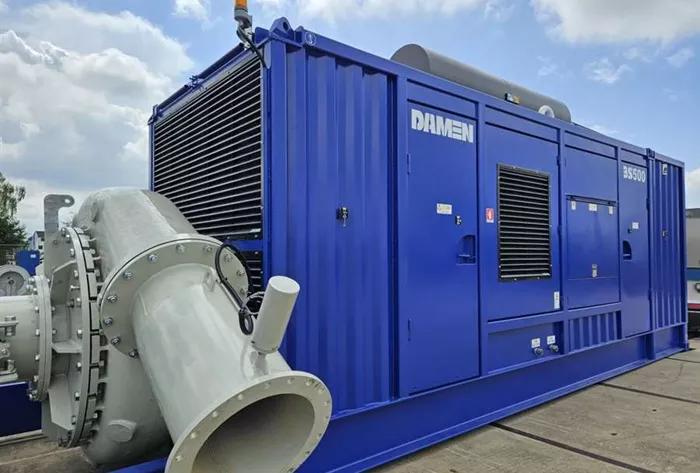In a move toward greener operations, Damen Shipyards has secured a contract with German dredging contractor Hegemann to supply a BS 500 booster station equipped with Damen’s innovative Marine NOx Emission Reduction System. The agreement, finalized in June 2024, highlights efforts to reduce environmental impact within the maritime industry.
At the time of the order, construction of the BS 500 booster station was already underway at Damen’s Dredging yard. The booster is powered by a Caterpillar 3512C diesel engine, delivering 954 kW, and is compliant with IMO Tier II emission standards. The station features a 500-mm pipeline connection dredge pump capable of producing approximately 4,000 cubic meters per hour.
The booster station began its first operation in Emden, northern Germany, in September 2024. It is connected to Trailing Suction Hopper Dredgers (TSHD) and is designed to extend the discharge distance of sand cargo.
Hegemann’s booster station will soon be retrofitted with Damen’s Marine NOx Emission Reduction System, ensuring compliance with both IMO Tier III and EU Stage V emission standards. This cutting-edge system integrates a silencer that combines Selective Catalytic Reduction (SCR) technology with a diesel particulate filter (DPF), achieving over 75% reduction in harmful emissions, according to Damen.
Though the system will be installed at a later date due to delivery schedules, its modular design allows for easy retrofitting, explained Joppe Neijens, Sales Manager at Damen. “Our Stage V Emission Reduction System is a practical add-on, designed for simple integration on top of the booster station’s container housing.”
Martin Janßen, Head of Inspection at Hegemann, expressed satisfaction with the project, stating, “We are committed to a greener future, and this investment in emission reduction reflects our dedication to responsible operations.”
This collaboration underscores the maritime industry’s increasing focus on sustainability and emissions control, ensuring that even powerful industrial machinery like booster stations can operate with a reduced environmental footprint.
Related topics:
- Webtec Launches HPM5000: A Mid-Size Hydraulic Data Logger for Advanced Machinery Diagnostics
- Volvo Group CEO to Keynote CES 2025, Focusing on Sustainable Transportation
- MAN Engines Expands Marine Portfolio with New EU Stage V Compliant Diesel Engine

